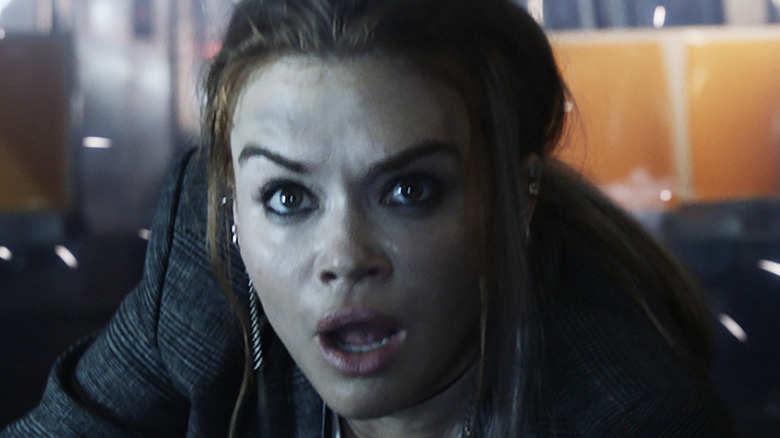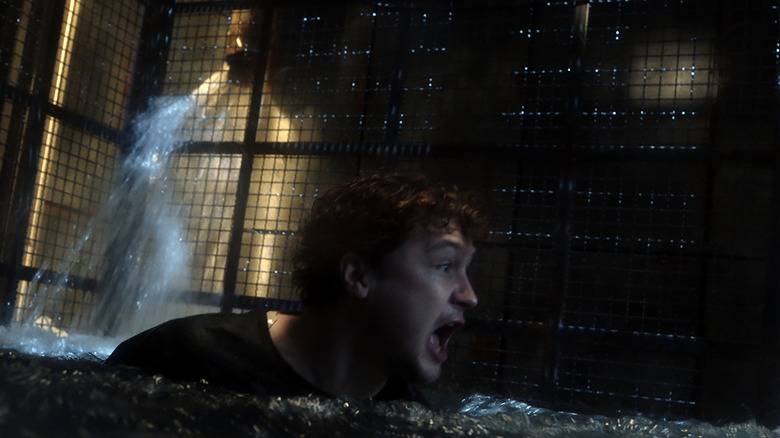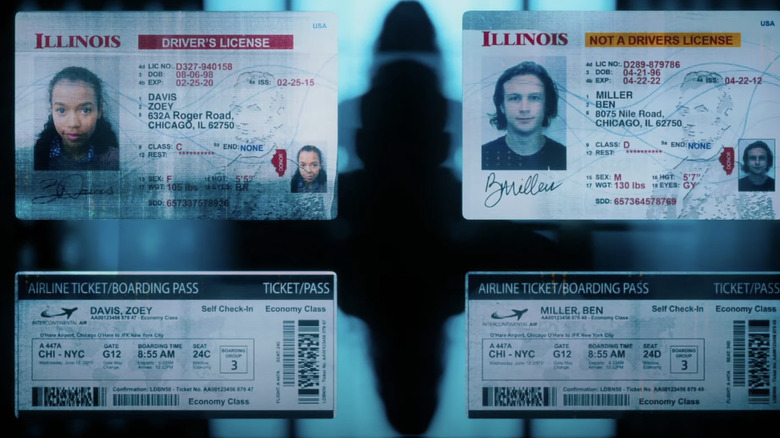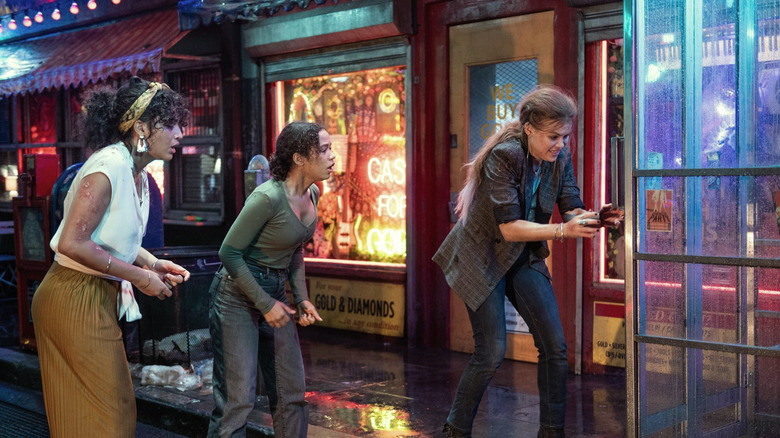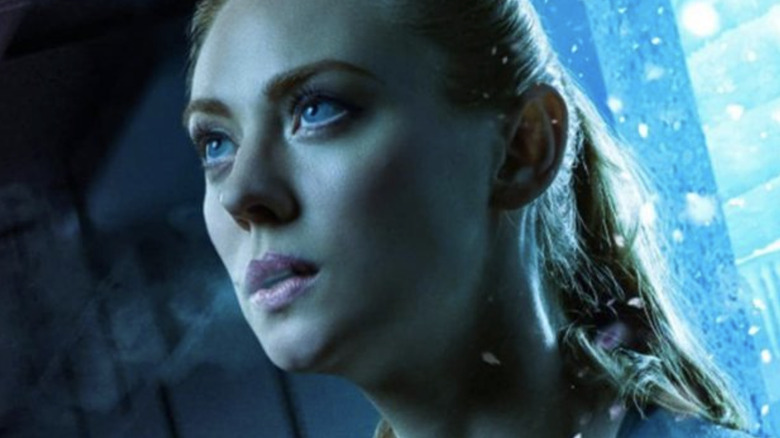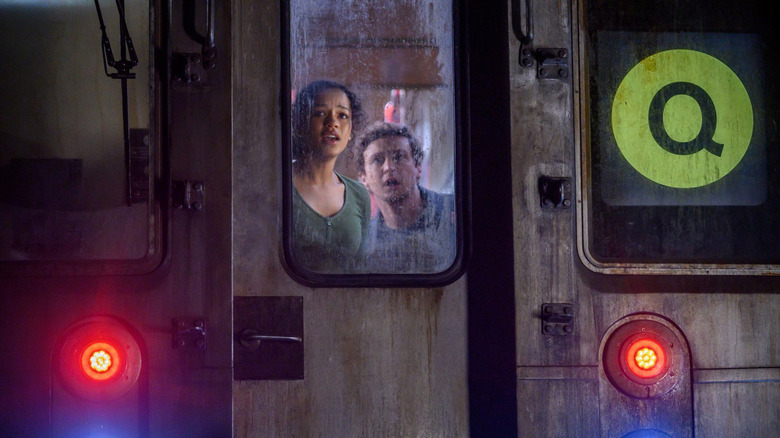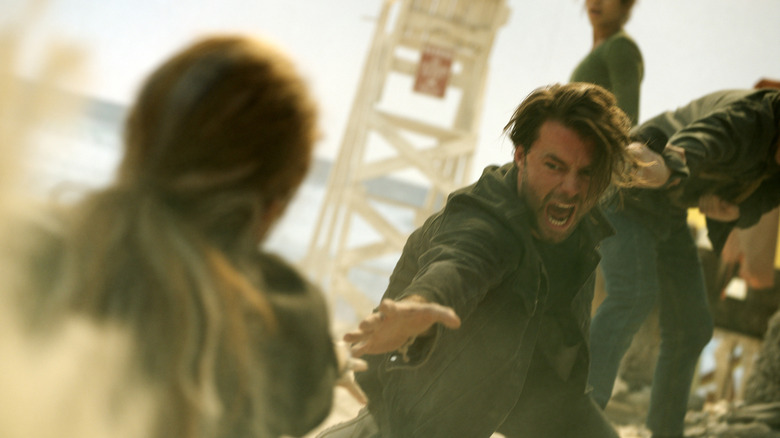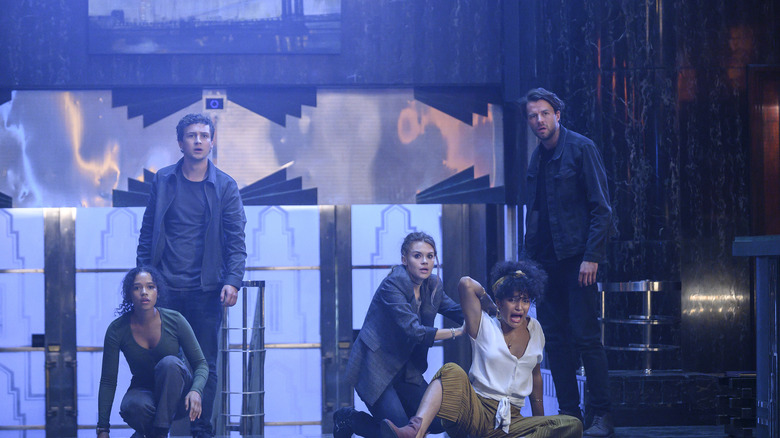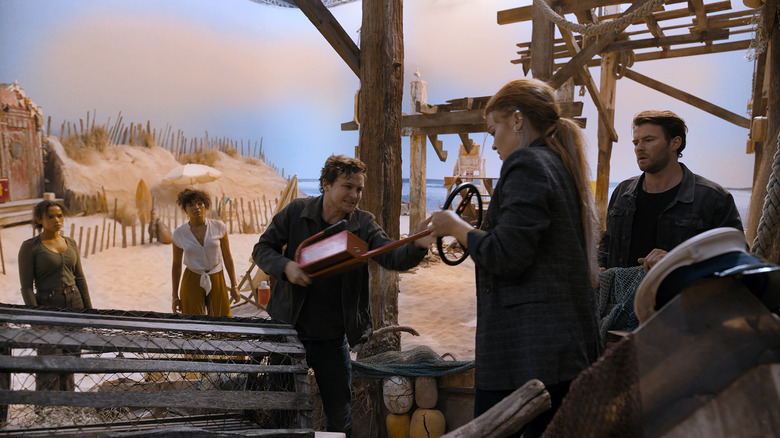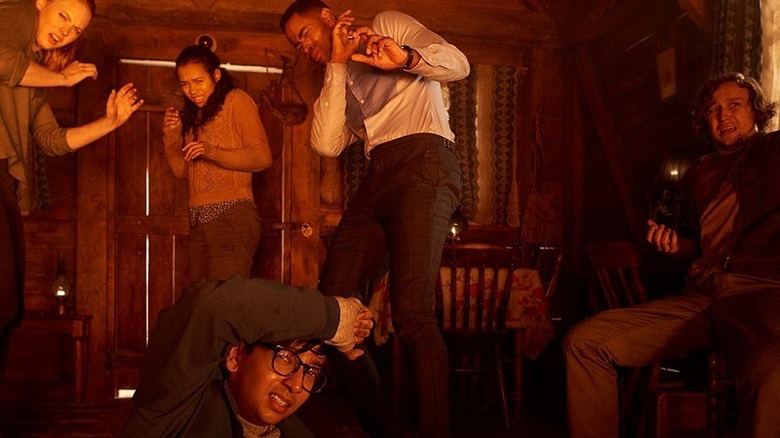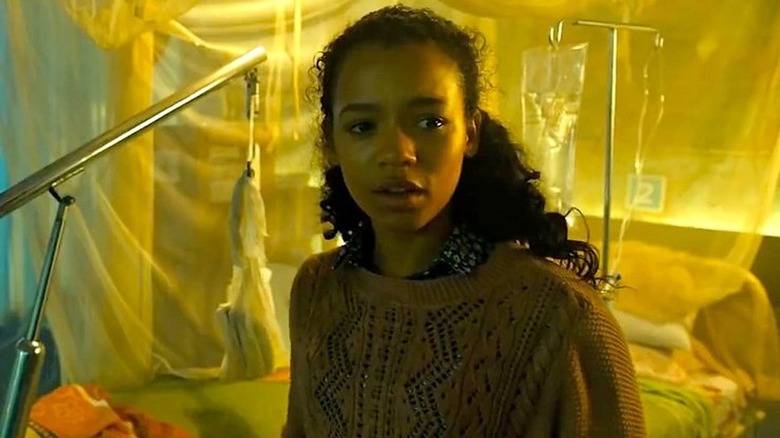The Ending Of Escape Room: Tournament Of Champions Explained
2019's "Escape Room" is a wild ride with a bonkers ending. The characters themselves never quite figure out what's going on, and even the audience is left to doubt what they see with their own eyes. We know that Minos, the secret organization that hoodwinks people into do-or-die escape rooms, is powerful. We know that their escape rooms are partially constructed with electronic barriers and high tech, and that they have friends in high places. Beyond that, however, the scope of their plans is never made completely clear.
As it turns out, Minos isn't quite finished with our main characters: The fiendish group has set up a new competition in "Escape Room: Tournament of Champions," in which previous survivors are pit against each other. Minos seems even bigger in this movie, casting everything the viewer sees into doubt. We don't know how far Minos' conspiracy extends, who's involved, or which victims die for real. Is Zoey's seemingly well-intentioned professor, who encourages her to take risks, in on the horrors of the first film? Is Zoey's therapist from the sequel involved? Everything is up for debate.
While it's impossible to find definitive answers in mind-bending psychological horror movies like this, we can discern some truths. Join us as we explore the mind-bending ending of "Tournament of Champions," from its mysterious planes to the meaning behind those strange shipping containers.
Meet the new class
At the end of 2019's "Escape Room," we learn that Minos chose each participant for their status as a sole survivor. "Tournament of Champions" introduces a host of new characters, who, like Ben and Zoey, have done this dance before. None are particularly keen on repeating the experience.
Soon enough, we learn about the qualities that got these characters sucked into Minos' machinations in the first place. Rachel can't feel physical pain, and likely faced horrifying psychological torture during her game. Brianna survived a game featuring notable influencers. Nathan entered the game with fellow priests, to test his faith. Each category is distinct, and offers insight into the human condition. By picking specific groups of people, Minos wants to test hypotheses about faith, pain, fame, empathy, and survival. They don't care who gets hurt in the process, and if it makes them a hefty sum of money? All the better.
Clearly, someone needs to make a deadly escape room for amoral rich people who hunt kids for entertainment. We all know that none of the Minos folks are going to go out of their way to sacrifice their own lives for the lives of others, so maybe Zoey should design the next puzzle and give the Minos crew a taste of their own medicine.
How deep does this conspiracy go?
While many things still aren't clear at the end of 2019's "Escape Room," we can say with certainty that Zoey and Ben aren't still trapped in the escape room when they leave the first game alive. We do see Minos planning their next game with Zoey, as well as Ben's intercepted flight information, however. Though the two champions may be back to their old lives, that doesn't mean Minos isn't still watching them. And given the number of people involved in the airplane testing at the first film's close, it's safe to say that Minos isn't exactly a small-time operation.
It's clear that Minos has people in the "real world" manipulating things from the outside, whether they're directly involved in Ben and Zoey's lives or placed on the outskirts to watch and report back. Furthermore, Minos is capable of hijacking a plane, an airport, and a subway train. You can't do that without major connections in those critically important fields.
What's more, since we don't see most of the "dead" characters actually die, there's no telling which players might have been Minos double agents from the start. The players first suspect Ben, after all. Could they have been right all along? Or is someone else pulling the strings?
So, who actually dies?
The deaths of the first film seem pretty cut-and-dry by the time that story draws to a close. But in light of the events of "Tournament of Champions," we have to question everything. If Amanda can survive hurtling into an endless abyss, who's to say that other apparently deceased characters didn't also cheat death? And which ones might have been involved with Minos from the jump?
In "Tournament of Champions," we're led to believe that everyone except Zoey, Amanda, and Ben bite the dust. But how true is that, really? As Amanda tells Zoey, if she didn't see the deaths herself, they didn't happen. Since Rachel checks out Theo's electrocuted body to determine he's actually dead, he's the likeliest actual casualty. But the other deaths are murkier.
After Nathan saves Rachel from quicksand, he sinks to his presumed death. But that's how we initially lose Ben, too. We later discover Ben survived, to serve as leverage for Zoey to follow Minos' bidding. It wouldn't be surprising if Nathan survived too, then. That brings us to Rachel and Brianna. We watch as a monsoon of acid rain assaults them, but the film quickly cuts to Zoey freaking out. The steam and smoke make it impossible to tell what really happens to them, which could be another trick. As Amanda says, "If you didn't see it, it didn't happen." Are they really gone?
The Amanda plot twist
What the heck is going on with Amanda? She shows up out of the blue toward the end of the movie, claiming Minos forced her into designing the game that Zoey just played. As she puts it, "Who better to design a game than someone who beat them?"
That's an interesting sentiment for her to express, considering Amanda doesn't come close to beating the game in the first film. She could be referring to Zoey instead of herself, but that'd be a bit of a weird comparison to make during a major reveal. Minos doesn't seem likely to applaud anything less than first place, and Amanda was one of the first few "casualties" in the 2019 film. While it's reasonable to believe that Minos might force her into designing the latest game — especially since the game appears to be Plan B — it's just as likely that our innocent Amanda has been a Minos plant all along.
While Amanda has mentioned her daughter, we never actually see any flashback clips with Amanda and Sonya. We do, however, see Amanda's time as a soldier, alongside the other characters' flashback sequences in the first film. The culmination of events at the end of the film feels way too easy, as even Zoey notes. It's entirely possible that Amanda isn't who she says she is. For all we know, Sonya is a total fabrication, invented to hoodwink Zoey into cooperation.
How big is the game?
A massive display of huge shipping containers can be glimpsed when the characters escape the creepy bedroom. They're labeled NYC, BDRM, BCH, and BNK. This seems likely to be short for New York City, bedroom, beach, and bank — in short, the escape rooms Minos throws the characters into during this go-round. At the top, of course, is our lone subway car. We also see a painting of an eight-ball, hinting that the original escape rooms might be in this underground bunker as well.
The games have to exist somewhere, of course, but the scope of the subway car and the NYC room is mind-boggling. Zoey and Ben appear to get on a real subway platform and a real Q train, as we see it dislodge at the beginning of the movie. That's a massive feat to pull off. Any New Yorker can tell you that the MTA is a hot mess on a good day, but building, hiding, and/or usurping an extra track wouldn't exactly go unnoticed — to say nothing of how Minos lured the other champions onto this particular car without anyone else hopping on. New Yorkers are a determined bunch, after all. The fact that Minos pulls off the subway heist of the century speaks to the connections and tech they have at their disposal. But it also tells us that reality isn't always what it seems.
The Minos Police Department
The subway car is likely a mix of reality and a few Minos adjustments. But what about the police station? When Zoey and Ben are on their doomed flight and Zoey questions how easy it all seems, Ben says, "You really think the whole police station was bulls***?" Yes, Ben. Yes, we do. If there really was a raid on Minos' extracurricular activities, the involved parties would be high-tailing it to a country without extradition laws, not throwing together another deadly escape room. So it seems, like everything else, that the news broadcast about four found bodies and a manhunt is fabricated.
That means the guy who steals Zoey's bag and compass at the beginning of the film is a Minos plant, who lures Zoey and Ben into the specific subway car. That also means his arrest is an illusion. Given how massive the police station is, this conspiracy goes dramatically deep — a staggering number of people must be on the Minos payroll. There are probably multiple cops pulling the strings and hiding evidence, at Minos' behest. It's too big of an enterprise not to have those kinds of connections in place.
The therapist's secret
While killer planes are certainly scary, learning a trusted ally is, in fact, a manipulative liar is even scarier. When someone talks to a therapist, they expose their vulnerabilities — to learn that their therapist is destabilizing their concept of reality would be devastating. Someone with deep-rooted PTSD from being trapped in a killer escape room would be especially shaken by this. While it's not abundantly clear that Zoey's therapist is involved with Minos, there are some pretty shady coincidences surrounding her.
First off, there's the lighthouse painting in the therapist's office, which foreshadows the beach escape room. Then, at the start of the film, the therapist encourages Zoey to take the trip to NYC with Ben. That's not entirely damning on its own: Part of a therapist's job is helping patients work through trauma to achieve some level of normalcy. Let's call this an orange flag, then — not quite a red flag, but not green, either.
From there, things get worse. Minos originally plans on hoodwinking Ben and Zoey with a hijacked flight. They move to Plan B when Zoey can't bring herself to get on the plane. What's Plan B? Oh, just a commandeered subway car. And what's the title of the book the therapist brandishes at Zoey while accusing her of finding clues in everything? "Free Will: How to Stop the Train of Negative Thinking." That's a little too much of a coincidence to not be a clue.
What's the deal with the airplane, anyway?
When Zoey gets on the Minos-sponsored flight, she sees the exact pen, purse, and book that her therapist uses. To make matters worse, she hears the "end of session" ringtone from the phone of someone who looks exactly like the good doctor. Now, that doesn't necessarily mean the therapist herself is in on it. But it does mean that, at the very least, Minos bugged her office and/or threatened her into cooperating. And that's not the only weird thing afoot involving planes.
Recall the end of the first film, which teases the flight simulation being prepped for Zoey and Ben. The coordinators pull up the duo's flight information, and we see boarding information for a flight from Chicago to New York. For a second, that makes it seem like the end of the first movie doesn't actually take place before the events of "Tournament of Champions." However, the details of the boarding pass tell us that they were prepping for the flight Zoey runs away from, causing a hasty change of plans. If Zoey had gotten on that first flight, the events of the sequel might never have happened — or the flight would have replaced the subway car method of getting the champions to the new escape room.
What does it all mean?
It's difficult to say for sure what exactly goes down in "Tournament of Champions," due to Minos' love of deception and digital trickery. The "why," however, isn't so muddy. The "Escape Room" franchise might bear similarities to horror titles like "Cube" and "Saw," but "Tournament of Champions" has a "Hunger Games" vibe — specifically, "The Hunger Games: Catching Fire." Just as that film forces previous Hunger Games winners to do battle, "Tournament of Champions" pits those who have survived Minos' escape room against each other.
The motivation for the games in both film series is simple: The wealthy view everyone who isn't part of their high-class circle as entertaining playthings. In "The Hunger Games," the bloodthirsty elite are the denizens of the Capitol. In the "Escape Room" movies, it's whoever's paying for a front-row seat to Minos' deadly games. They say that money can't buy happiness, but apparently it can buy gladiator-style death matches. Through this, the "Escape Room" series critiques societal stratification and wealth's corruption of morality, as well as offering a glimpse at the horrific things people can do with technology, if they're so cruelly inclined.
Among all of the perks privilege can buy is anonymity: Minos and all of its wealthy patrons are able to remain unknown. They hide behind their technology, torturing kids for fun from an ivory tower while everyone else gets their hands dirty. In contrast, Zoey and Ben don't have the luxury of disappearing behind a dollar sign.
Soul survivors
The "Escape Room" movies deeply explore what it means to be a survivor, and the lengths to which someone will go to save themselves. Who will fight for others, this series asks, and who will simply save their own life? The premise of the first film hinges entirely on survival. Each unwilling participant's "sole survivor" background tells Minos something about who they are, whether it's Jason killing his best friend or Ben drunkenly (but unintentionally) killing his friends in a car crash.
But something about Zoey saving Ben continues to pique Minos' interest. While the rest of the champions' games seem to have been one-and-done experiments, Minos remains fixated on the concept of the survivor. Why else would they throw previous survivors in one ring to duke it out yet again? The rest of the survivors appear to be cannon fodder, as Minos' sight remains fixed on Zoey and their desire for her to build them a new game. Zoey continues to survive, despite the criminally low odds of living through the game. This makes her the perfect person to design a genuinely unbeatable escape room sequence ... but she'll never agree to it. Or will she?
What will it take to break?
Though Minos is interested in how Zoey continues to survive, they're equally invested in calculating the stakes needed to finally break her. This is easier said than done: Even when they hold Ben hostage, Zoey finds a workaround. But an organization like Minos won't give up so easily. Zoey's fall would justify their own twisted actions, as Minos wants to prove that people will always choose to save themselves in extreme situations. Or, at the very least, Minos wants to confirm that Zoey is willing to sacrifice innocent people if it saves someone she loves.
It's a rendition of the classic trolley problem thought experiment: Can you justify harming a few people to save many more? Would you sacrifice many people to save the one you love? So far, Minos has failed on that front. Yet what better way to force Zoey to her breaking point than recreating the plane crash that killed her mother?
Digging up her deeply embedded trauma is Minos' best bet to force a breakdown even more substantial than the one we see at the end of the first film. Threatening Ben and a slew of seemingly innocent passengers might just be enough to get Zoey to design the next game. Minos' twisted games are psychological experiments and grisly entertainment: They'd count Zoey's breakdown a success in both categories.
